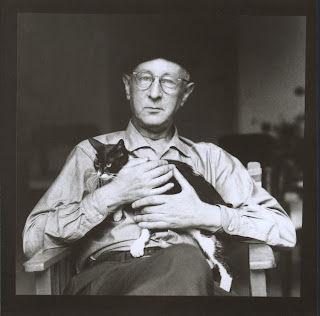A Concert and a Painting 1911
On Monday, January 2nd, 1911, there was an historic concert in Munich. The program was devoted entirely to the music of Arnold Schönberg: two string quartets, five lieder, and three short pieces for piano. I doubt anyone in the audience at the time would have considered the concert significant, let alone historic, except for Schönberg and his circle – and one man who had recently arrived in Munich, Wassily Kandinsky. He was so taken with Schoenberg's music that he made this sketch for a painting:
The sketch indicates colors for the final work: 'Schw[arz]' = black for the piano; 'gelb' = yellow for a mass or large space on the lower right; and 'w[eiß]' = white for the two posts and the dress of the pianist, Etta Werndorff (see Schönberg's more figurative portrait of Werndorff below).
In the painting, the figures in the sketch have all been shifted up and to the left, leaving the large mass of yellow below the diagonal on the lower right. It appears (to me at any rate) that the triangular 'crowding' of the concert in this way gives the impression of extreme concentration – a kind of 'leaning in' or 'pressing together'. Perhaps the effect of the yellow is from Kandinsky's idea that yellow surfaces seem to move closer to us while blues (such as those hovering over the pianist) tend to move away. The first time the two met was several weeks after the concert. Kandinsky sent Schönberg a note on January 18th (the paint would have still been wet on Impression III) expressing how his music paralleled the direction he was heading in painting: 'What we are striving for and our whole manner of thought and feeling have so much in common that I feel completely justified in expressing my empathy.' In late 1911, less than a year after that momentous concert, Kandinsky published Concerning the Spiritual in Art. Discussing the outer and inner aspects of art – a distinction he is making between conventional and deep beauty – he speaks of music, and especially Schönberg:
❝[Hearing the
music of Debussy and Scriabin, the listener] is often snatched quite suddenly
from a series of modern discords into the charm of more or less conventional
beauty. He feels himself often insulted, tossed about like a tennis ball over
the net between the two parties of the outer and the inner beauty. To those who
are not accustomed to it the inner beauty appears as ugliness because humanity
in general inclines to the outer and knows nothing of the inner. Almost alone
in severing himself from conventional beauty is the Austrian composer, Arnold
Schönberg. . . . His music leads
us into a realm where musical experience is a matter not of the ear but of the
soul alone – and from this point begins the music of the future.❞[1]
|
But back to the concert. What was it that so impressed Kandinsky? The answer comes from looking at the original program.
The four songs, composed in 1903-5, while chromatic, are certainly 'tonal'. The First String Quartet (1904/5) is, after all, in D minor. The Second Quartet (1907/8) is hardly 'traditional' and is tending to the extremes chromatically; the soprano – not exactly an expected guest for a string quartet – gives us a premonition of things to come when she sings the words of poet Stefan George, 'I feel air from another planet'). But with all its tonal meandering, this quartet is still in (or around) F-sharp minor.
The real break with 'conventional beauty' came with the second work on the program, those three little piano pieces written in 1909. Fifteen minutes of what would become possibly the most analyzed and argued over music ever written. Here was the birth of what we still, despite the absurdity of the word, call 'atonality'. These pieces – the prevised 'air from another planet' – were what likely set Kandinsky's hair on end. And those three pieces were what he sketched and then painted. His impression of Etta Werndorff under a blue halo, alone at the piano – and the dominating mass of aggressive yellow as it begins to envelope the audience.
Arnold Schönberg
Drei Klavierstücke, Op. 11
Performed by Filippo Gorini
Recorded live at the third round of the Telekom-Beethoven Competition Bonn 2016
where Gorini was first prize winner
& winner of the audience prizes in both semifinal and final rounds
___________________________
[1] Wassily Kandinsky. Concerning the Spiritual in Art. Ch. III, 'Spiritual Revolution'. English translation by Michael T.H. Sadler first published by Constable and Co., Ltd., London, in 1914 under the title The Art of Spiritual Harmony.






Comments
Post a Comment